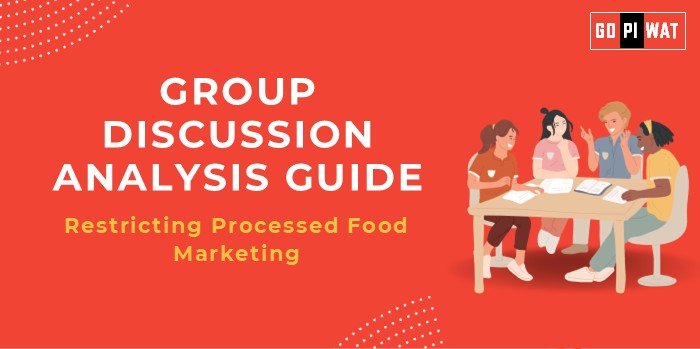📋 Group Discussion (GD) Analysis Guide: Processed Food Marketing and Public Health
🌐 Introduction to the Topic
📖 Opening Context
Processed food marketing significantly influences consumer behavior, especially among vulnerable populations such as children. With rising obesity rates and associated health concerns, governments worldwide are debating the need for stricter regulations on how these products are marketed.
📜 Topic Background
The processed food industry has grown exponentially over the past few decades, driven by aggressive advertising strategies. However, this growth has coincided with increasing cases of non-communicable diseases like diabetes, hypertension, and cardiovascular illnesses. Countries such as the UK, Chile, and Canada have pioneered restrictions on advertising unhealthy food to curb these trends.
📊 Quick Facts and Key Statistics
- 🌍 Global Obesity Rate: Over 1 billion people are classified as obese, including 340 million children (WHO, 2023).
- 💰 Processed Food Sales: $4.5 trillion globally in 2022, with significant expenditure on marketing.
- 📺 Advertising Impact: Exposure to junk food ads increases children’s calorie intake by 30% (Harvard Public Health).
- 🇨🇱 Chile’s Success: Banned cartoon characters on junk food packaging, resulting in a 24% reduction in sugary drink consumption within two years.
🤝 Stakeholders and Their Roles
- 🏛️ Government: Enact and enforce marketing regulations to protect public health.
- 🏢 Processed Food Companies: Develop and advertise healthier alternatives.
- 👥 Consumers: Demand transparency and healthier options.
- 💼 Healthcare Providers: Advocate for policy changes based on public health data.
- 🌍 Global Organizations: WHO and UNICEF promote guidelines for responsible food advertising.
🏆 Achievements and Challenges
✨ Achievements
- 🇨🇱 Chile: Reduced sugary drink consumption by 24% after marketing restrictions.
- 🇬🇧 UK: Banned junk food ads before 9 PM on TV, protecting children.
- 🇨🇦 Canada: Implemented mandatory warning labels, influencing purchasing decisions.
⚠️ Challenges
- 💼 Corporate Pushback: Companies argue such bans restrict free market operations.
- 📉 Economic Impact: Potential loss of jobs in marketing and advertising.
- 🔍 Enforcement: Monitoring digital platforms for non-compliance is complex.
🌎 Global Comparisons
- 🇳🇴 Norway and Sweden: Restrict advertising to children under 12, reducing unhealthy food purchases.
- 🇧🇷 Brazil: Partial restrictions lacked robust implementation, leading to limited impact.
💡 Structured Arguments for Discussion
- 👍 Supporting Stance: “Restricting processed food marketing is vital to reduce obesity rates and healthcare costs, as seen in Chile and the UK.”
- 👎 Opposing Stance: “Marketing bans infringe on free market principles and might hurt small businesses in the processed food sector.”
- ⚖️ Balanced Perspective: “While restrictions are necessary, governments should also incentivize companies to market healthier options.”
📈 Effective Discussion Approaches
🔑 Opening Approaches
- 📊 Statistical Impact: “Over 340 million children are obese globally; regulating food ads is a critical step to curb this trend.”
- 📖 Case Study Reference: “Chile’s marketing restrictions reduced sugary drink sales by 24%, showing the power of regulations.”
🤔 Counter-Argument Handling
- 💡 Acknowledge concerns about economic impacts but highlight the long-term healthcare savings.
- 📚 Emphasize successful case studies with measurable outcomes.
🔍 Strategic Analysis of Strengths and Weaknesses
- 🌟 Strengths: Reduces childhood obesity; encourages healthier consumer habits.
- ⚠️ Weaknesses: Economic impact on food companies and job losses.
- 🚀 Opportunities: Promoting local and organic food industries.
- ⚡ Threats: Corporate lobbying and lack of public awareness.
📚 Connecting with B-School Applications
- 🌐 Real-World Applications:
- 📣 Marketing: Study ethical marketing practices.
- 📊 Strategy: Analyze case studies on corporate adaptation to regulations.
- 💬 Sample Interview Questions:
- 🧠 “How can governments balance public health goals and economic interests?”
- 📈 “What role should businesses play in promoting healthier lifestyles?”
- 💡 Insights for B-School Students:
- 🤝 Consider public-private partnerships for health campaigns.
- 📊 Analyze the economic ripple effects of regulatory decisions.


